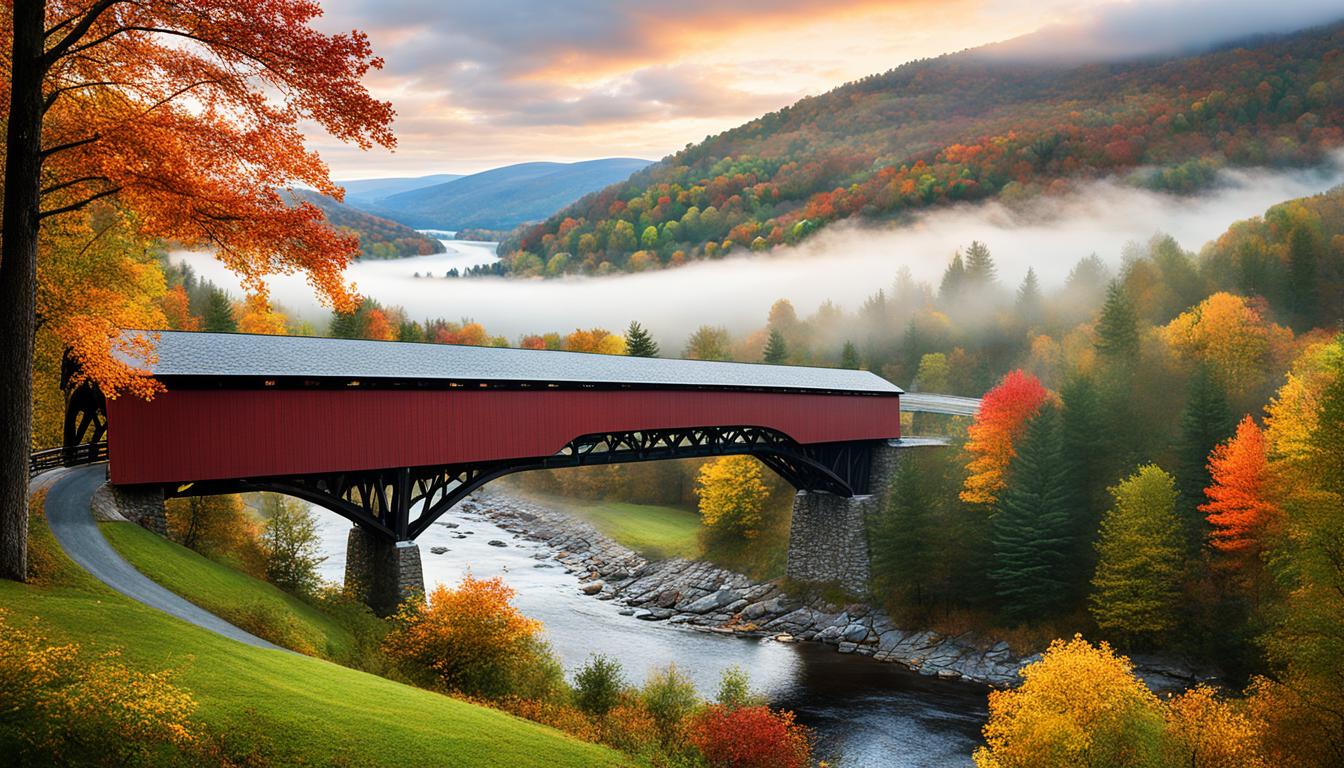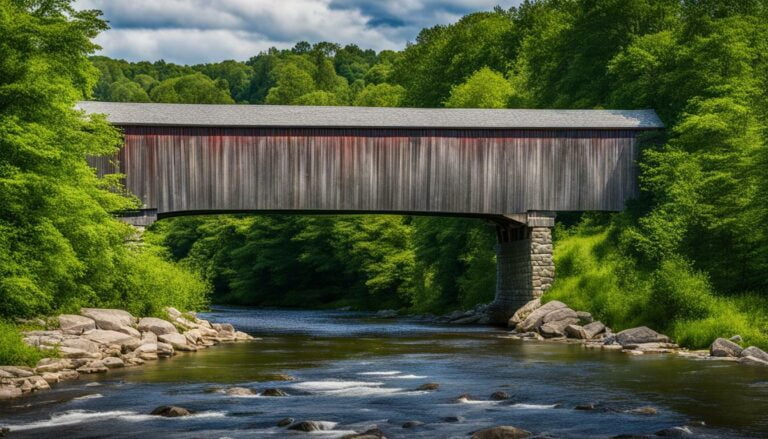Charming Crossings: Exploring Vermont’s Picturesque Covered Bridges
What secrets do Vermont’s historic covered bridges hold? They offer a peek into the state’s rich history and nature, besides their charm. There are more than 100 of these iconic covered structures in Vermont. It has the highest number in the U.S., making it a top spot for visitors eager to see them.
Vermont’s historic covered bridges date back to the 1800s. They beautifully stretch over rivers and streams. Places like Stowe and Smugglers’ Notch are home to these iconic bridges. They are favorites for photos, winning over the hearts of those who see them.
But what makes Vermont Covered Bridges such lasting symbols? Are they just pretty pieces of the past? Or, do they have deeper meaning for Vermonters and their guests? Let’s dive into the reasons behind their charm. Here, you’ll learn how they’ve become essential to the state’s scenic tours and photography.
Key Takeaways
- Vermont is home to the highest concentration of covered bridges in the United States, with over 100 historic structures.
- These iconic bridges, dating back to the 1800s, elegantly span rivers and streams, offering captivating glimpses into the state’s rich history and natural beauty.
- Vermont’s covered bridges have become beloved landmarks and popular photography subjects, drawing visitors from around the world to experience their unique charm and grace.
- From the quaint village of Stowe to the rugged terrain of Smugglers’ Notch, these charming crossings serve as essential elements of the state’s scenic tours and photography experiences.
- Uncovering the deeper significance and enduring appeal of Vermont’s covered bridges is the focus of this exploration.
The Allure of Vermont’s Covered Bridges
Vermont’s covered bridges were built to shield their wooden parts from the weather. This helped them stay important for travel for many years. Now, these old bridges keep us interested with their unique design and history.
They make the perfect scene for any photo, blending in with Vermont’s natural beauty. With rolling hills and quiet rivers nearby, they welcome visitors anytime. Their beauty shines whether it’s a bright autumn day or a peaceful winter evening.
Historic Treasures Spanning Rivers
Vermont’s covered bridges are more than historic sites. They are year-round favorites for people who love nature and taking pictures. In the fall, they’re surrounded by bright leaves. Winter turns them into snowy scenes that are just as stunning.
No matter the season, these bridges are inviting and rich with history. They draw us to their enduring charm.
Vermont Covered Bridges: A Driving Tour

One of the best ways to see Vermont’s covered bridges is by taking a scenic drive. This route from Stowe to Smugglers’ Notch is perfect. It passes through beautiful villages, farmlands, and mountains. You can stop to look at the bridges, take great photos, and enjoy Vermont’s beauty.
Scenic Routes through Historic Villages
The tour brings you through lovely Vermont villages. They all have unique covered bridges and rich history. From the Kissing Bridge in Rockingham to those over the West River in Dummerston, you’ll see the best of Vermont. It’s a chance to soak in the state’s beauty and history.
Picturesque Farmland and Mountain Passes
There’s more to see than just bridges on this tour. You’ll drive through farms and over mountains. The views are amazing. You might see a bridge in the hills or with the Green Mountains behind it. This journey is something you’ll always remember.
Highlights of Vermont’s Iconic Covered Bridges

The Kissing Bridge in Rockingham is one of Vermont’s most well-known covered bridges. It stands near the iconic Vermont Country Store. Named for a tradition, it was a spot for couples to steal a kiss in their horse-drawn carriages. Today, it draws visitors who love the simple beauty of these old structures.
The Windsor-Cornish Bridge is the longest covered bridge in the US, spanning 449 feet across the Connecticut River. It was first built back in 1866, replacing bridges lost to floods. This bridge showcases the skill and dedication of its 19th-century constructors. It has been carefully maintained, keeping its historical value alive.
Pulp Mill Bridge: Oldest in Vermont
The Pulp Mill Covered Bridge in Middlebury dates back to around 1820, making it Vermont’s oldest. It is special for being one of seven double-laned bridges still in use. This bridge’s historical importance is clear, given its place on the National Register of Historic Places.
West Dummerston: Longest Entirely in Vermont
Built in 1872, the West Dummerston Covered Bridge is Vermont’s longest bridge at 280 feet. It spans the picturesque West River. Designed by Caleb Lamson, it’s a beautiful example of 19th-century bridge design. It is cherished for its historic value and beauty.
Brown Bridge: Unique Slate Roof
The Brown Covered Bridge in Shrewsbury was built in 1880. What makes it stand out is its rare slate roof. It’s the only covered bridge in the US with a roof like that. This unique feature, along with its town lattice truss design, sets the bridge apart as a special piece of history.
Conclusion
Vermont’s covered bridges are famous symbols that draw in people from different places. They offer a special view of Vermont’s history and beauty. Locations like the Kissing Bridge and Windsor-Cornish Covered Bridge capture the hearts of those who visit. These old bridges keep their magic alive, making Vermont a top pick for many.
When exploring Vermont, either by car or on foot, these bridges will charm you. They stand tall with their wooden frames, each telling a story of Vermont’s past. Photography lovers and adventurers alike find joy in these structures. They add to the state’s character and are loved by all who visit.
The Pulp Mill Bridge and West Dummerston Covered Bridge are just two examples of Vermont’s famous landmarks. They are among the oldest and longest bridges in the state. These sites give people a quiet spot to enjoy nature and history. Vermont’s covered bridges will always be part of what makes the state special, attracting visitors from far and wide.







